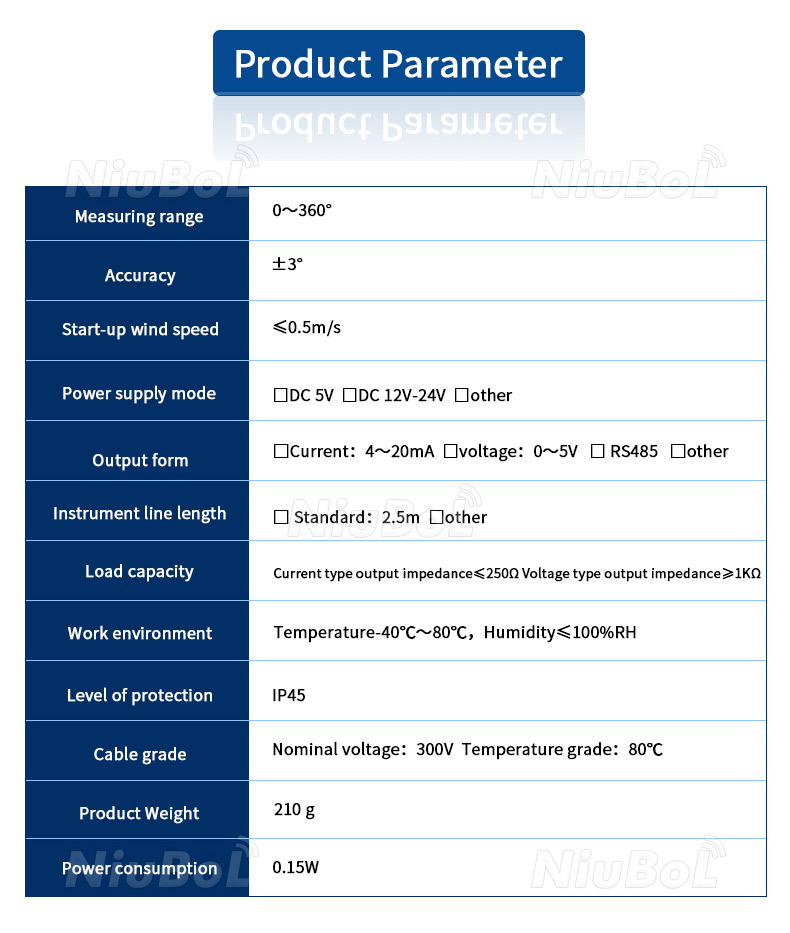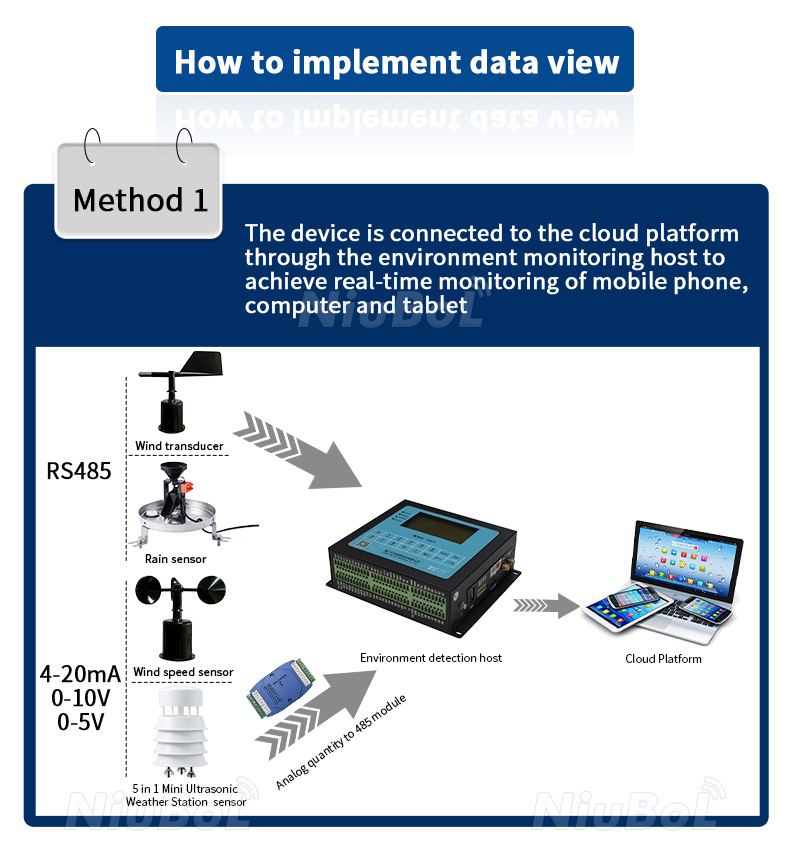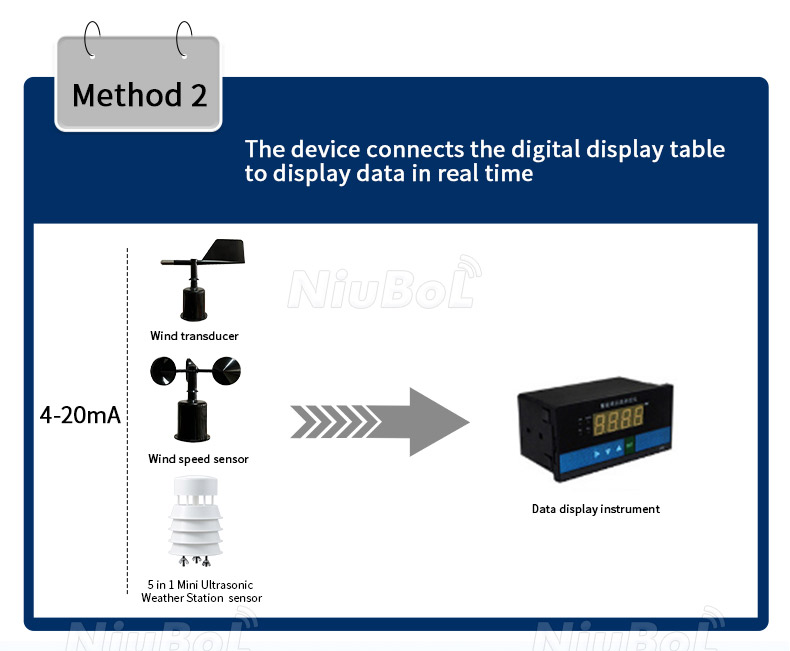

— Blogs —
—Products—
 Consumer hotline +8618073152920
Consumer hotline +8618073152920 WhatsApp:+8615367865107
Address:Room 102, District D, Houhu Industrial Park, Yuelu District, Changsha City, Hunan Province, China
Product knowledge
Time:2024-06-30 21:28:29 Popularity:1548
Introduction to Wind Speed and Direction Sensors
Wind speed and direction sensors are devices used to measure information such as wind speed and direction in the atmosphere. They are commonly used in meteorology, environmental monitoring, aerospace, marine engineering, and agriculture. They are often used as an integral part of a weather station or weather tower to collect and record key data about the wind.
Wind Speed Sensor (Anemometer):
Wind speed sensors are used to measure the speed of the wind, i.e. the speed at which it flows, usually in meters per second (m/s) or knots. They make measurements according to different principles and technologies, including the following common types:
- Cup Anemometer: One of the most common wind speed sensors measures wind speed by the speed of a rotating cup. The higher the wind speed, the faster the cup spins.
- Hot-wire Anemometer: Uses a thin heated wire to determine wind speed by measuring how quickly the wind cools the wire.
- Ultrasonic Anemometer: Uses an ultrasonic transducer to measure wind speed and usually has no moving parts, resulting in a longer service life and greater accuracy.
Wind direction sensor:
Wind direction sensors are used to measure the direction of the wind, i.e. the direction from which the wind is blowing, usually expressed as an angle or bearing (e.g. north, east, south, west). They usually consist of a sensitive direction sensor or transducer mounted on a fixed bracket that ensures an accurate indication of wind direction in all weather conditions.
Common technologies for wind direction sensors include:
1. compass wind vane: the wind force acts on a weight on the vane to make it point in the direction of the wind.
2. Electronic Wind direction Sensors: Using a principle similar to that of wind speed sensors, wind direction is measured by electronic components.

Functions
1. Wind Speed Measurement: A wind speed and direction sensor can accurately measure the speed of the wind in the environment. It usually uses a rotating rod or ultrasonic working principle to realize the measurement. By calculating the distance of the wind passing through the sensor per unit time, the value of wind speed can be obtained.
2. Wind direction measurement: the sensor can also measure the direction of the wind. It usually uses the principle of wind vane or magnetic sensitivity, according to the wind direction on the sensor to measure the wind direction, generally expressed in 360 degrees.
3. Data output: the sensor can be measured wind speed and wind direction data output. Usually use digital signal output, such as analog voltage signal or digital interface output, easy to access the data acquisition and analysis system.


Wind speed and direction sensor Usage Scenarios
1. Meteorological observation: wind speed and wind direction sensor is an important equipment in meteorological observation, which is widely used in meteorological stations, meteorological satellites and other environments, used to collect and analyze meteorological data, providing an important basis for weather forecasting and climate research.
2. Aerospace: In the design and operation of aircraft, accurate wind speed and direction information plays a key role in safety. Wind speed and direction sensors can provide real-time wind conditions to help pilots or automatic navigation systems make corresponding adjustments to ensure navigation safety.
3. Architectural design and engineering: In architectural design and engineering, understanding the wind conditions in the environment is critical to the stability and structural design of buildings. Wind speed and direction sensors can provide accurate wind speed and direction data to help engineers assess the impact of wind on buildings and design reasonable wind protection measures.
4. Agriculture and fisheries: Irrigation of farmland and air circulation in farms are very important for the growth of crops and animals. Wind speed and direction sensors can provide accurate wind speed and direction information to help farmers and breeders rationally arrange irrigation and ventilation to improve yield and efficiency.
5. Air pollution control: wind affects the spread of air pollutants and diffusion range, so the use of wind speed and wind direction sensors can predict the direction of spread of air pollutants and diffusion range, to help air pollution control work.
6. Construction sites: in many construction sites have the need for aerial work, the wind has a great impact on the safety of aerial work. The use of wind speed and direction sensors can provide assistance for safe operation.
7. Mining and tunneling safety: in mines and tunnels and other scenarios, good ventilation is a guarantee of the safety of the operating personnel. The use of wind speed and wind direction sensors can monitor the operation of ventilation equipment and mine ventilation conditions, to provide assistance for safe work.
8. Environmental Monitoring: In environmental monitoring, especially in air quality monitoring and pollution control, wind speed and direction are essential for predicting the spread and propagation of air pollution.
9. Marine Engineering: In marine engineering, such as offshore platforms, ships and harbor operations, wind speed and direction sensors help plan and conduct safe marine operations.
10. Wind power: Measurement of wind resources provides data for optimized operation of wind turbines.
In summary, wind speed and wind direction sensors have a wide range of applications in a number of fields, especially in areas where accurate weather data is required, and their accurate and reliable data provide an important basis for decision-making in various fields, helping to improve safety, efficiency and productivity.
NBL-W-SS-Wind-Speed-Sensors-Instruction-Manual-V4.0.pdf
Related recommendations
Sensors & Weather Stations Catalog
Agriculture Sensors and Weather Stations Catalog-NiuBoL.pdf
Weather Stations Catalog-NiuBoL.pdf
Related products
 Combined air temperature and relative humidity sensor
Combined air temperature and relative humidity sensor Soil Moisture Temperature sensor for irrigation
Soil Moisture Temperature sensor for irrigation Soil pH sensor RS485 soil Testing instrument soil ph meter for agriculture
Soil pH sensor RS485 soil Testing instrument soil ph meter for agriculture Wind Speed sensor Output Modbus/RS485/Analog/0-5V/4-20mA
Wind Speed sensor Output Modbus/RS485/Analog/0-5V/4-20mA Tipping bucket rain gauge for weather monitoring auto rainfall sensor RS485/Outdoor/stainless steel
Tipping bucket rain gauge for weather monitoring auto rainfall sensor RS485/Outdoor/stainless steel Pyranometer Solar Radiation Sensor 4-20mA/RS485
Pyranometer Solar Radiation Sensor 4-20mA/RS485
Screenshot, WhatsApp to identify the QR code
WhatsApp number:+8615367865107
(Click on WhatsApp to copy and add friends)
